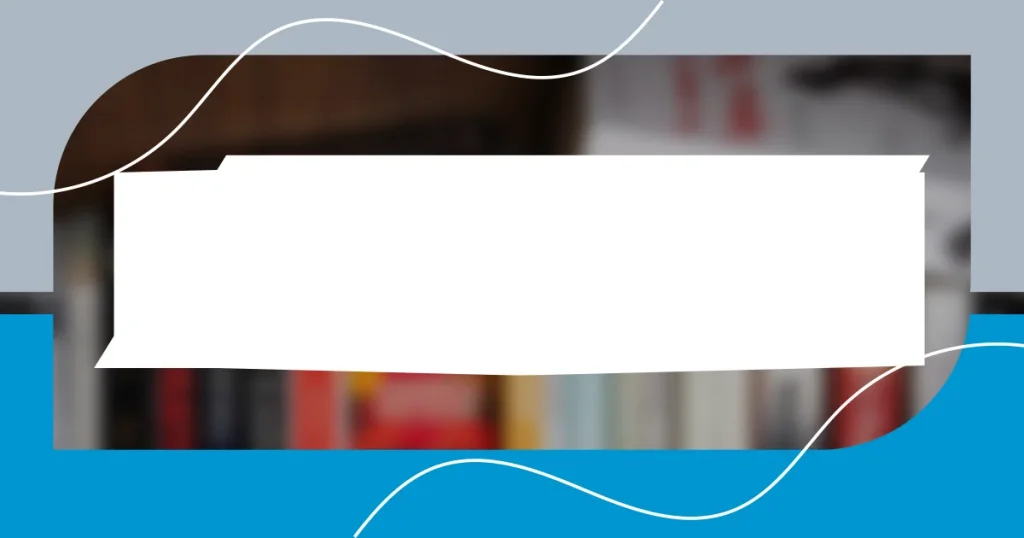Key takeaways:
- Genre blending enhances creativity, emotional depth, and character complexity, allowing writers to explore unique narrative possibilities and challenge conventional storytelling norms.
- Techniques such as establishing a strong tone, character cross-pollination, and adaptive plotting are essential for effectively merging genres and maintaining coherent narratives.
- Successful examples of genre blends, like “The Night Circus” and “Get Out,” illustrate how mixing genres can deepen emotional resonance and provoke critical societal discussions.

Understanding genre blending
When I first started blending genres, I was surprised by how liberating it felt. I recall writing a story that mixed fantasy elements with a gritty crime narrative, merging two worlds I loved. It seemed almost like magic—by intertwining these genres, I created something unique that resonated with my feelings about good vs. evil in an unexpected way.
Engaging with genre blending allows you to break free from conventional storytelling structures. I often wonder how many stories remain untold simply because writers fear venturing outside established categories. This exploration pushes boundaries and invites readers into a more nuanced experience, where the familiar meets the unknown, igniting curiosity and deeper emotional connection.
As I examined my own work, blending genres often revealed layers of character development I hadn’t anticipated. For instance, a character who started as a classic hero evolved into something more complex because of the unexpected twists from a horror backdrop. Isn’t it fascinating how introducing a new genre can breathe life into stagnant narratives? Embracing this approach not only enhances creativity but also allows for a richer emotional palette to engage the reader.

Reasons to blend genres
Blending genres opens the door to endless storytelling possibilities. I remember crafting a tale that mixed romantic comedy with elements of supernatural thriller. It was exhilarating to watch how my characters navigated the chaos of a haunted relationship, allowing laughter and suspense to dance together in a way that not only entertained but also revealed deeper truths about love and fear. This experience solidified my belief that genre blending can create relatable scenarios while also challenging our perceptions.
Here are several compelling reasons to embrace genre blending in storytelling:
- Enhanced Creativity: Combining genres can spark new ideas and perspectives, pushing writers to think outside the box.
- Wider Audience Appeal: Blending genres attracts readers with diverse tastes, broadening your storytelling reach.
- Richer Emotional Experience: Mixing genres can evoke a wider range of emotions, making narratives feel more relatable and impactful.
- Complex Characters: As I discovered, unique genre pairings can lead to multidimensional characters that defy traditional archetypes.
- Challenging Norms: Breaking genre conventions can question societal norms, encouraging readers to think critically about their world.
Overall, blending genres not only enriches the narrative but can also leave a lasting impression on both the writer and the audience.

Techniques for blending genres
Blending genres can be an adventurous journey, and one technique I often use involves establishing a strong tone that weaves through both genres. For example, when I integrated a whimsical fantasy backdrop into a dark thriller, the contrasting tones created an intriguing atmosphere that compelled readers to explore the duality within the narrative. I found that a carefully chosen voice allowed me to maintain the integrity of both genres while enhancing the overall storytelling experience.
Another technique that has served me well is character cross-pollination. There’s something truly exhilarating about taking a character from one genre and placing them in the context of another. I remember taking a detective from a classic noir setting and dropping him into a surreal, dystopian landscape. This twist not only offered fresh challenges for the character but also revealed deeper layers of his personality that a single-genre restriction never would have uncovered.
When it comes to plotting, I believe it’s essential to remain adaptable. Mixing genres can lead to unexpected turns and plot developments that keep both the writer and the reader engaged. I vividly recall a moment when a lighthearted comedy took a sudden dive into a psychological horror twist. The shift was shocking, yet it enhanced the narrative tension, drawing readers deeper into the story. This kind of bold maneuver can redefine a genre and elevate the storytelling to new heights.
| Technique | Description |
|---|---|
| Tone Establishment | Weaving a unique tone that captures the essence of both genres to enhance the reading experience. |
| Character Cross-Pollination | Taking characters from one genre and placing them in contrasting contexts to reveal new layers and challenges. |
| Adaptive Plotting | Remaining flexible with plot developments to embrace unexpected turns, maintaining a captivating narrative flow. |

Creating unique characters
Creating unique characters is one of the most rewarding aspects of storytelling, especially when blending genres. I once wrote a story where the protagonist was a quirky inventor from a steampunk world who unwittingly found herself in a modern-day heist. Watching her navigate both her fantastical gadgets and the gritty reality of the crime world allowed me to explore themes of ingenuity and adaptation. It made me wonder—how do our strengths shine in unfamiliar environments?
When crafting characters across genres, I often draw inspiration from the contradictions that make us human. I designed a somber detective with a penchant for poetry in a fast-paced action story. This contrast not only added depth but also allowed for some unexpected humor when he recited verses in the middle of a chase. Have you ever noticed how seemingly opposing traits can enhance a character’s complexity? It’s a delightful puzzle to solve.
Another instance that stands out is when I blended the worlds of horror and romance. I created a vampire with a deep yearning for connection, which defied typical tropes. By allowing her backstory of loneliness to emerge within a suspenseful plot, I could evoke empathy from readers, making them root for a character who might otherwise seem monstrous. This experience reminded me that even dark figures can hold a vulnerability that resonates with us. It’s a beautiful challenge to create characters that feel real, no matter the genre.

Developing a cohesive plot
Developing a cohesive plot when blending genres can sometimes feel like juggling flaming torches while riding a unicycle. I’ve learned that every scene must carry the weight of both influences. For instance, in a recent story that merged romance with science fiction, I focused on the emotional stakes of a love affair against the backdrop of an intergalactic conflict. This allowed me to not only drive the plot forward through tension and passion but also maintain coherence in how each element interacted with the other.
One thing I’ve found incredibly useful is establishing a central theme that resonates across both genres. When writing a mystery that incorporated elements of magical realism, I centered the investigation around the concept of lost memories. This shared theme created a thread that guided readers through the fantastical elements while maintaining the seriousness of the detective work. Have you ever noticed how a unifying theme can make even the most disparate elements feel like they belong together? It’s a powerful storytelling tool.
Navigating plot points can certainly be tricky, but I’ve discovered that setting clear character motivations helps anchor the narrative. I remember crafting a story where a reluctant hero, caught between the demands of a dystopian rebellion and the allure of a romantic subplot, had to make heart-wrenching choices. The tension stemming from her conflicting desires not only enhanced the plot but also kept readers invested in her journey. It’s in those climactic moments of choice where the heart of a blended narrative truly shines.

Balancing different styles
Balancing different styles might feel daunting, but it can lead to incredibly rich storytelling. I remember working on a mystery infused with magical realism, where each twist had to maintain the enigmatic feel while adhering to the logical structure of a traditional whodunit. I found myself constantly asking, “How can I keep the reader guessing without straying too far into the fantastical?” This challenge pushed me to creatively blend the ethereal with the rational, crafting an experience that felt both immersive and cohesive.
One of the strongest lessons I’ve learned in balancing styles is the importance of tone. I once wrote a narrative that mixed humor with a serious social commentary. It was a delicate dance—ensuring the comedic moments didn’t undermine the gravity of the topic. I often questioned, “How much levity is too much?” Ultimately, I realized that the humor served as a bridge, allowing readers to engage with tough themes without feeling overwhelmed. Finding that equilibrium fosters a connection, drawing readers deeper into the story.
Moreover, I’ve discovered that pacing plays a crucial role in harmonizing different styles. In a fast-paced adventure where I introduced elements of romance, I had to be strategic about when to slow down the narrative to explore emotional beats. I often paused to let the characters breathe, asking, “What do they need to communicate at this moment?” It’s in those quieter instances that I found an opportunity to deepen the reader’s investment and create a multi-layered experience that resonates long after the last page is turned. Balancing these elements can transform a simple plot into a vibrant tapestry of experiences.

Examples of successful genre blends
One genre blend that really caught my attention was the combination of historical fiction and fantasy in “The Night Circus” by Erin Morgenstern. When I first opened its pages, I felt instantly transported—not just to a different time but to a world brimming with magic. This blending allowed me to explore the intricacies of a love story set within a mesmerizing circus, where the fantastical elements heightened the emotional stakes. Have you ever encountered a story that made you long for its world? This one certainly left me wishing I could step straight into its enchanting tents.
In my own work, I beautifully merged horror and romance in a short story about two spirits bound by tragic love. As I crafted each scene, the eerie atmosphere complemented their haunting relationship, making their struggles all the more poignant. I realized that blending these genres not only enhanced the tension but also gave readers a unique lens through which to experience both fear and yearning. It poses an interesting question: Can fear be romantic? This interplay certainly made me rethink conventional boundaries in storytelling.
A particularly strong example of genre blending lies in the film “Get Out,” which seamlessly integrates horror and social commentary. The way Jordan Peele juxtaposes the eerie and the intellectual left me both disturbed and deeply reflective. As I watched, I wondered how such a blend could speak to current social issues so effectively. The film doesn’t just entertain; it invites a dialogue about race and privilege, proving that blending genres can elevate a narrative from simple storytelling to profound commentary. Have you found a story that challenges your perceptions in this way? It’s these powerful examples that inspire me to continue pushing the limits of genre in my own writing.
















